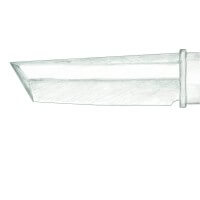Both the oldest and the most recent history of knife making have produced countless blade shapes, the most common of which we would like to introduce and explain to you here. The blade shapes have been shaped by the respective requirements as well as by the traditional aesthetic ideas of their regions of origin. Contemporary custom knifemakers are constantly enriching this diverse family, so we can only give an overview of the most common designs here.
Straight Back Blade
The straight back blade is sometimes called the "normal shape", which is why it heads the list here. It is characterised by a straight back and a largely parallel cutting edge. The cutting edge usually runs in a wide radius towards the back of the blade. The back-pointed blade originates from the Scandinavian tradition and is often found on fixed knives of this type. In the harsh weather-beaten landscape, knives have always been universal tools for hunting, fishing, woodworking and leatherworking. The parallel part of the cutting edge pulls well into the carving material when carving. The fine point is good for cutting tight curves in tanned leather.
Centre-point Blade
The centre-pointed blade has been found since the middle of the 19th century, especially on unlocked pocket knives. The cutting edge and the spine run largely parallel and sometimes meet exactly at the tip, sometimes more or less in the middle of the blade width. The medium-pointed blade is easy to control for everyday tasks such as cutting out an apple core. Due to its robustness, it also finds application in fixed driving knives of older types.
Droppoint Blade
The droppoint blade is formed by two wide arcs of the cutting edge and the spine. The edge is more curved so that the tip is above the width of the blade. The back slopes downwards, as it were, which is where the name "droppoint" comes from. The droppoint blade is usually wide and robust and is particularly popular with modern hunting knives, as it can be used to break open and strike out of the blanket easily. The less pronounced tip of the blade reduces the risk of damaging the guts or the blanket.
Spearpoint Blade
The spearpoint blade can have quite different silhouettes, e.g. the shape of a medium pointed blade or a droppoint blade. The back of the blade, however, is provided with an additional bevel of varying length towards the tip, which is often referred to as a "false edge" and is called a Schor in traditional Solingen parlance. The main characteristic of the Spearpoint blade is therefore not so much the silhouette as the type of bevel.
Clippoint Blade
The clippoint blade, also called Bowie blade, is a common European classic, probably of Anglo-Saxon origin. For fixed knives, the term bowie blade is most commonly used. Old-established Solingen manufacturers also refer to sabre knives as "Säbelskniep". The blade has an inward curve at the tip, often with a false edge. Clippoint blades are used universally in the outdoor sector and also characterise many survival knives or classic bayonets.
Hawkbill Blade
The Hawkbill blade has the shape of a claw, with the cutting edge curved inwards. The oldest model is possibly the karambit from the Indonesian and Malaysian regions. The karambit was originally a harvesting knife for herbs and rice plants. The hawkbill blade is predestined for cross-cutting and is often found in folding gardener's knives, but also in rescue knives for mountaineers or sailors. In a way, it is a folding sickle on a small scale.
Tanto Blade
The Tanto blade originates from the martial Japanese tradition. In today's American Tanto, the primary and secondary cutting edges are usually separated from each other by a distinct corner in the course of the cutting edge, as shown above. In the classic Tanto, on the other hand, the cutting edge and blade run parallel in a gentle curve. The tip is steeply set off with a narrow radius towards the back of the blade. This tip is extremely robust and had the function of piercing plate armour in ancient Japan.
Persian Blade
The Persian blade, also called upswept or trailing point blade, originates from Iran and Arabia. The cutting edge exceeds the spine, which in turn is curved upwards and ends in a usually concise point.
Recurve Blade
The recurve cut is found on various blade shapes and does not so much refer to the blade shape itself as to the S-shaped course of the cutting edge. This often makes the blade front-heavy and makes it suitable for larger fixed knives, especially for house cuts similar to a machete. On smaller knives, the rear concave part of the edge is suitable for cross-cutting.
Dagger Blade
While a separation of utility and combat knives only gradually emerged in the 15th century, the use of the dagger blade has always been relatively restricted. The dagger blade is medium pointed, usually symmetrical and sharply ground on both sides. In addition to the typical double-edged diamond profile, there are more rarely three-edged daggers. Some outdoor enthusiasts rely on the second edge to have a second sharp edge in case of emergency or to apply a steeper grinding angle for rougher work. With the same blade width and thickness, a dagger grind is always accompanied by a duller cutting edge angle than a corresponding single-edged blade, and thus a lower sharpness than a utility blade.












